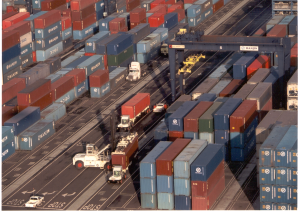The aim of the TPP is to further expand trade between the U.S. & Canada and other nations bordering the Pacific. (This does not include China, which is not a party to the pact). At same time, completion of a program to widen the Panama Canal means more huge container ships will travel directly to the East coast from Pacific countries. Clearly, rising trade with distant countries – especially those with similar plant genera – raises the risk of pest introductions. Stress federal and state agencies that are already struggling to counter this threat.
The question is whether the TPP agreement itself will exacerbate this threat. Is there language in the agreement that will further hamper adoption and deployment of effective phytosanitary programs?
Fortunately, I think largely not.
The TPP’s section on sanitary and phytosanitary programs – Chapter 7 largely reiterates or clarifies procedures already included in the WTO SPS Agreement and International Plant Protection Convention. TPP provides additional clarity on some points, e.g., transparency & communication.
(Unfortunately, I believe that the SPS Agreement and IPPC already hamper efforts to protect our trees from alien pests – especially those that are not yet known – the infamous “unknown unknowns”. For my analysis see Fading Forests II, available here. A more optimistic analysis of the SPS Agreement as an obstacle to preventing pest introductions is provided by Burgiel et al. 2006, available here.
I am quite pleased to see that the TPP explicitly allows importing countries to consider their level of confidence in the exporting country’s phytosanitary capability when deciding what measures to impose – a very important improvement! This occurs twice:
• Article 7.8: Equivalence
5. In determining the equivalence of a sanitary or phytosanitary measure, an importing Party shall take into account available knowledge, information and relevant experience, as well as the regulatory competence of the exporting Party. [emphasis added]
• Article 7.10: Audits
6. A decision or action taken by the auditing Party as a result of the audit shall be supported by objective evidence and data that can be verified, taking into account the auditing Party’s knowledge of, relevant experience with, and confidence in, the audited Party. This objective evidence and data shall be provided to the audited Party on request. [emphasis added]
I am also pleased that the TPP acknowledges the need to act proactively in the face of a threat. Under Article 7.1, Definitions, the definition of “emergency measure” reads:
“ … a sanitary or phytosanitary measure that is applied by an importing Party to another Party to address an urgent problem of human, animal or plant life or health protection that arises or threatens to arise in the Party applying the measure;” [emphasis added]
The TPP also puts protecting human, animal, or plant life or health first – before facilitating trade – when specifying the agreement’s objectives. See Article 7.2: Objectives, paragraph (a), which reads:
(a) protect human, animal or plant life or health in the territories of the Parties while facilitating and expanding trade by utilising a variety of means to address and seek to resolve sanitary and phytosanitary issues;
The TPP reiterates parties’ rights under the World Trade Organization’s SPS Agreement and IPPC to adopt more stringent regulations as long as they justify such action by both adopting a higher level of protection and conducting a risk assessment appropriate to the circumstances. See especially Article 7.9, paragraph 2:
2. Each Party shall ensure that its sanitary and phytosanitary measures either conform to the relevant international standards, guidelines or recommendations or, if its sanitary and phytosanitary measures do not conform to international standards, guidelines or recommendations, that they are based on documented and objective scientific evidence that is rationally related to the measures, while recognising the Parties’ obligations regarding assessment of risk under Article 5 of the SPS Agreement.
I do worry some about Article 7.11, Import Checks, paragraph 8, which states:
8. An importing Party that prohibits or restricts the importation of a good of another Party on the basis of an adverse result of an import check shall provide an opportunity for a review of the decision and consider any relevant info submitted to assist in the review. The review request and info should be submitted to the importing Party within a reasonable period of time.
How does this requirement apply to the U.S. policy of rejecting shipments in wood packaging that does not comply with ISPM#15? (For discussions of the role of wood packaging as a pathway for introduction of highly damaging pests, review my blogs posted on July 15, August 31, September 11, and October 30.) The U.S. does not currently consult with exporting country before denying entry to individual shipments. Nor do we want the U.S. to be required to do so!
Finally, Article 7.17: Cooperative Technical Consultations, paragraph 5 requires countries to involve “relevant trade and regulatory agencies” but says nothing about including other stakeholders, such as cities or homeowners whose trees are at risk to introduced pests.
Posted by Faith Campbell
